I recently attended the San Francisco Conservatory of Dance for their six-week immersive summer dance program. We would dance—ballet, contemporary style dance, improvisation, and rehearsal—for up to 8 hours a day, 6 days a week. Of course, though I lived in the vastly interesting city of San Francisco for six whole weeks, the rigor of the program left me with only five Sundays to explore what I could.
The intensity of the program was exhausting physically and mentally; in between classes, we would have short breaks to eat and rest, but more often than not classes were two to four hours in length. The teachers preached mental stamina and encouraged us to find our energetic limits. Then, when our energy supply was seemingly low, they would push us to access more energy, which felt impossible until you did it. Despite this physical “exhaustion,” every Sunday morning I would wake up rearing to go, with energy I knew didn’t need to reserve for class the next day because, among the countless lessons I learned while attending SFCD, I learned this: no matter the level of your fatigue, you always have more energy to exhaust.
One Sunday, a friend of mine and I went to Muir Woods National Monument in Sausalito, California, an enormous national park with trails and groves, “known for its towering old-growth redwood trees”
(www.nps.gov/muwo/index.htm). We left early in the morning; a metro ride, a ferry across the bay, and a shuttle got us there in about 90 minutes, with plenty of time to take on a couple trails. The trail we chose was quite ambitious: it started with a gentle climb of forest-ingrown stairs, and from then on continued strictly upwards.
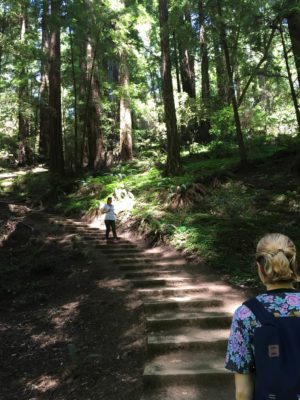
Five minutes into the trail, we were both mildly out of breath; ten minutes in, we were sweating. I remember, at one point, saying to my friend, “I’m so glad we chose to do something physical on our day off; it’s like mild cross-training but with the most wonderful views.”
And the views truly were stunning: trees covered in red-seeped bark stretched to heights higher than 350 feet, seeming infinite in their reach. Their canopies kept us cool on the 85-degree day. We climbed, navigating the thin path-entangled with winding tree roots; to the right of the path, the forest floor curved sharply upwards towards the many bases of more redwoods and underbrush; to the left, a cliff dropped steeply, displaying at our eye-level the midsection of the trees’ trunks.
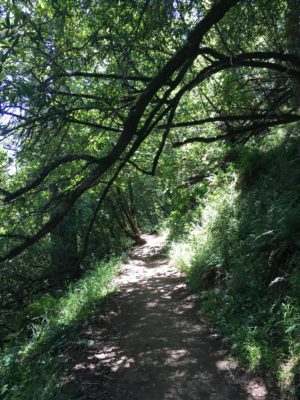
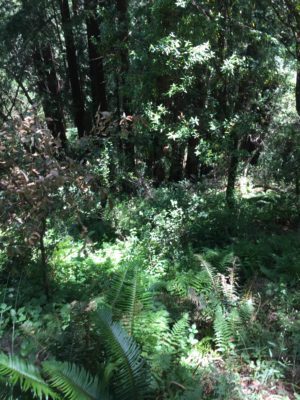
An attempt to capture the beauty and depth of cliff to the left of the trail… we were pretty high at this point.
Dried up, nature-made rain drains appeared occasionally on our right, and we would take small excursions off the path to challenge our balance on the rocks and fallen logs of those miniature rivers. Often during those excursions, our clumsy selves would skid, lose our footing, and end up seated on the mulchy forest floor, dirtying our clothes just enough to satisfy the instinctive urge to bond with nature. Up and up and up we climbed, running into only those few humans who had bravely chosen the not-quite-so-leisurely upward climb.
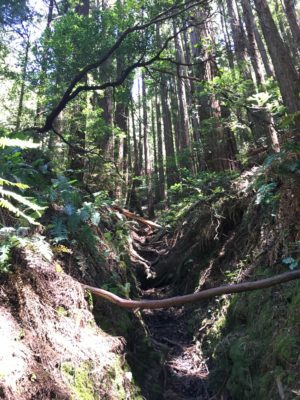
Rain-drain
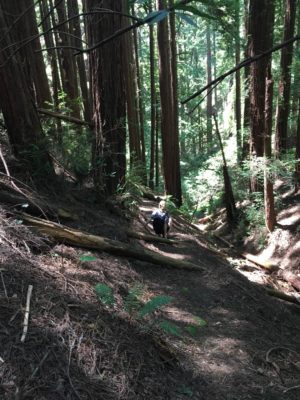
A mini excursion and forest bonding
An hour in and with heaving lungs, burning calves, and warmed thighs, we stopped at a plateau only 30 feet below the canopy of the redwoods to eat a snack and drink some water. A wooden signpost map informed us that the only way forward from there was downward.
The way down was nothing extraordinary, if not more difficult than the way up—the way your feet hit the ground on a steep incline feels awkward and is strangely more tiresome than the way up. At ground level, though, we ran into these beautiful sights:
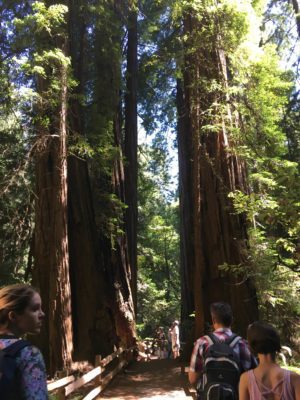
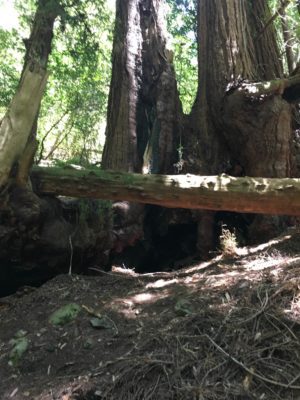
Hiking the redwood trails is no extraordinary feat; it’s no Everest, or heck, even a mountain at all—just the hills of California with wonderfully tall trees that provide shade, a habitat for countless wildlife, and crisp, breathable air for our lungs. It’s nothing to earn a reward for, but of all the activities we could have chosen on our day off, I’m glad my friend and I decided to push our physical limits.
Push your limits! It’s worth it.
Julia Dooley
About the author:
Julia is a senior at the University of Michigan this year. She majors in Dance with a minor in Computer Science. Although she has dealt with a genetic disease, Cystic Fibrosis since the age of 7, she doesn’t let it get in the way of living her life to the fullest. Her past time favorites consist of playing the piano, reading novels, and practicing her skills on the water for her tournament season this fall with the UofM Water Ski Team. Here she competes in all three categories: slalom, trick, and jump.


